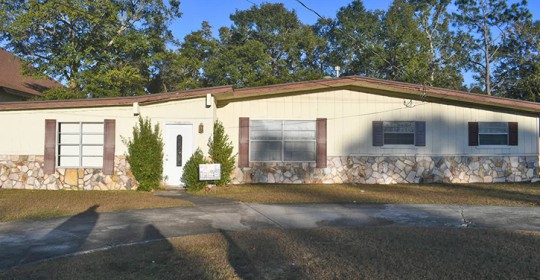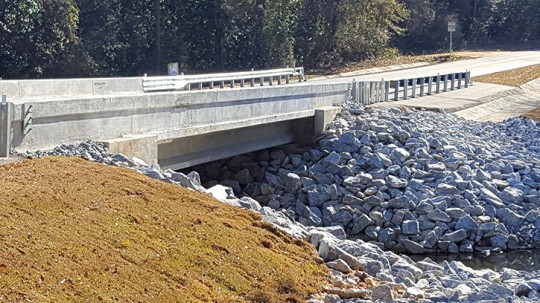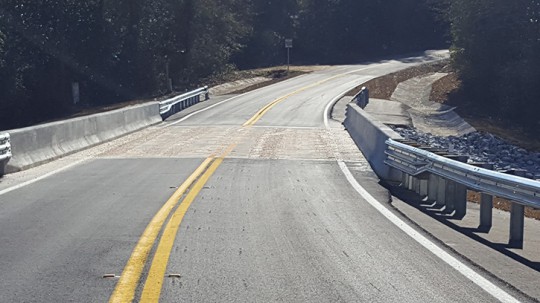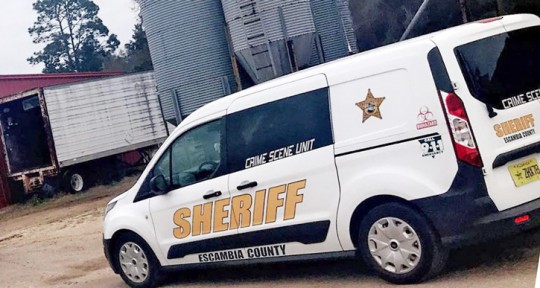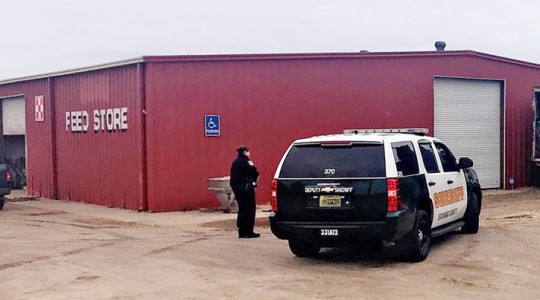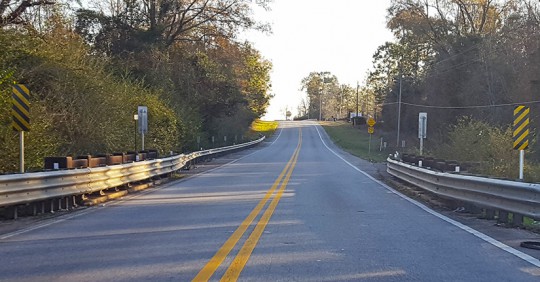Charity’s Plans Revealed For House For Families Displaced By Fire
January 5, 2018
The Escambia County Professional Firefighters Charity has released details on a house they plan to serve as temporary refuge for families displaced by residential fires in Escambia County.
The house, located just off Creighton Road, will serve as a temporary home for fire victims for up to two weeks at no cost,” said Ian Ian Sumner, charity coordinator. “We don’t want to them to worry about paying for anything while they are here, down to meals.”
When a family is displaced by a fire that damages their home, the American Red Cross usually provides them with up to two nights in a local hotel. Sumner hopes the charity’s home will be able to provide an immediate place for fire victims to stay for a couple of weeks.
“It will provide them a place to stay and get back on with their lives,” he said.
Sumner said the process of recovering after a fire can be a daunting task, with or without insurance.
“There is a lot that has to be done, from replacing things even to getting emergency refills of prescriptions that were destroyed in the fire,” he said. The Firefighter’s Charity plans to work with the families that stay in home to help them connect with any community service organizations that may able to assist them.
As for the house, it currently belongs to Potential Church and is need of a complete remodel “from the roof down”. Sumner said.
The Escambia County Professional Firefighters Charity is reaching out to the public for help in getting the home ready — from donations of time, money or materials. They plan to start work on the house in February and hope to have it ready for fire victims within a year.
The chair will hold their annual fundraiser, the “Fire and Ice Gala” on Saturday, March 10 at the Hilton Pensacola Beach from 6 p.m. until midnight. Tickets are $60 for the event, which will feature dinner, a silent auction and door prizes. Sponsorship opportunities are also available from $100 to $5,000 for the Fire and Ice Gala.
For information on how to donate, sponsor the Fire and Ice Gala or to learn more information, contact Ian Sumner at (850) 698-3105.
Pictured top: An rendering of the future look new Escambia County Professional Firefighters Charity house. Pictured below: A current photo of the house. NorthEscambia.com photo by Kristi Barbour, click to enlarge.
Scott, Nelson Take Aim At Trump Offshore Drilling Plan
January 5, 2018
Gov. Rick Scott and U.S. Sen. Bill Nelson, widely expected to battle this year for Nelson’s Senate seat, said Thursday they both intend to fight a Trump administration plan to open previously protected parts of the Atlantic Ocean and eastern Gulf of Mexico to offshore oil and gas drilling.
Scott said he has requested a meeting with Interior Secretary Ryan Zinke to discuss opposition to President Donald Trump’s effort to expand domestic energy production.
“Based on media reports, it is likely that the Department of the Interior will consider Florida as a potential state for offshore oil drilling — which is something I oppose in Florida,” Scott said in a prepared statement shortly before Zinke unveiled the drilling proposal Thursday. “I have already asked to immediately meet with Secretary Zinke to discuss the concerns I have with this plan and the crucial need to remove Florida from consideration.”
Scott was not the only Florida Republican criticizing the proposal.
U.S. Rep. Vern Buchanan, a Republican from Longboat Key, called the proposal “reckless, misguided and potentially catastrophic to Florida.”
“As the state with the longest coastlines in the continental United States, Florida is especially vulnerable to oil spills,” Buchanan said. “Have we forgotten so soon the devastating damage caused by the Deepwater Horizon disaster in 2010?”
But the Florida Petroleum Council, an industry group, hailed the Trump administration move as a way to benefit Florida consumers by potentially creating jobs and additional government revenue while strengthening national security.
“Allowing us to explore our offshore energy will boost our state economy and spur investment — all while safely coexisting with our agriculture, tourism and fishing industries as well as U.S. military operations,” council Executive Director David Mica said in a statement. “The administration has recognized that the ability to access our abundant offshore resources in a safe and environmentally responsible way will help our nation meet our energy needs well into the future.”
Mica said Florida relies on natural gas for nearly 70 percent of its electricity and that the industry is “constantly developing and improving safety standards, programs, new technologies, and best practices to protect our workers, the environment and marine life.”
Floridians will get a chance to comment on the proposal Feb. 8 at the Four Points by Sheraton in Tallahassee. The hearing is one of 23 that will be hosted by the Bureau of Ocean Energy Management across the nation between Jan. 16 and Feb. 28.
Aliki Moncrief, of the Florida Conservation Voters, described the proposal as “reckless” and added that “it’s refreshing to see (Scott) catching up with what Sen. Nelson has been saying for years.”
The topic of oil drilling did not come up Sunday when Scott had lunch with Trump in Palm Beach County, Scott spokesman John Tupps said.
White House press secretary Sarah Huckabee Sanders on Thursday said the administration will continue to work with Scott.
“Our goal certainly isn’t to cross Gov. Scott,” she said during a daily press briefing. “Just because we may differ on issues from time to time doesn’t mean that we can’t have an incredibly strong and good relationship.”
In the announcement Thursday, Zinke said nearly all of the nation’s outer continental shelf — a jurisdictional term describing submerged lands 10.36 statutory miles off Florida’s west coast and 3 nautical miles off the east coast — will be considered for drilling.
In 2017, Trump signed an executive order asking Zinke to consider opening the Atlantic Ocean and the Arctic to drilling.
Under Zinke’s proposal, which must still go through a public comment period and potential revisions before being finalized, 90 percent of the nation’s offshore reserves would be open to leasing between 2019 and 2024. Money raised from the leases would go toward improving national parks.
Nelson, a Democrat, panned the plan as “an assault on Florida’s economy, our national security, the will of the public and the environment.”
“This proposal defies all common sense, and I will do everything I can to defeat it,” Nelson said in a statement.
In 2006, Nelson and then-U.S. Sen. Mel Martinez, R-Fla., brokered a deal to ban drilling off Florida’s Gulf Coast through 2022.
Nelson has long maintained that oil rigs being “too close” to Florida’s shoreline could impact the state’s tourism-driven economy and military training areas in the eastern Gulf of Mexico.
Environmental groups expressed a similar view Thursday.
“The plan proposes to expand offshore oil drilling everywhere, including in our most sensitive waters,” Earthjustice President Trip Van Noppen said in a statement. “It puts irreplaceable wildlife and coastal communities at risk for the sole benefit of big oil, and it takes us in exactly the wrong direction on the urgently needed transition to a clean energy future.”
Nelson’s statement on Thursday came a day after he announced plans to invoke a procedural rule known as the Congressional Review Act to try to block efforts to roll back safety standards the Obama administration put in place after the 2010 Deepwater Horizon disaster.
The issue of offshore drilling also could confront state lawmakers during the annual legislative session, which starts Tuesday.
Sen. Doug Broxson, R-Gulf Breeze, and Rep. Mel Ponder, R-Destin, have proposed a resolution (SR 550 and HR 319) seeking to maintain a decades-long moratorium against oil drilling in an area of the eastern Gulf of Mexico used by the military for air and sea training.
The resolution, introduced last month, asks Congress to maintain the moratorium, which is in place from east of the Military Mission Line, which runs south of Hurlburt Field in Okaloosa County, to Key West. The moratorium is set to expire in 2022.
“The military missions require day and night access to the airspace, from the surface up to 60,000 feet, for high-speed flying and maneuvering, as well as day and night access to the seaspace, from the sea surface to the subsurface areas, for use by ships and submarines,” the resolution says.
by Jim Turner, The News Service of Florida
Winning Fantasy 5 Ticket Worth Nearly $200K Sold In Davisville
January 5, 2018
Someone is nearly $200,000 richer this morning after purchasing a winning Florida Lottery Fantasy 5 ticket in Davisville.
 The ticket sold at the Korner Kwik Stop, 10481 Highway 97, was the only winning ticket sold for Thursday night’s drawing and is worth $198,985.90.
The ticket sold at the Korner Kwik Stop, 10481 Highway 97, was the only winning ticket sold for Thursday night’s drawing and is worth $198,985.90.
The 292 tickets matching four numbers won $109.50 each. Another 9,401 tickets matching three numbers are worth $9.50 each, and 90,332 ticket holders won a Quick Pick ticket for picking two numbers.
Thursday’s Fantasy 5 winning numbers were 2-7-8-22-31.
New Bridge Open On Sandy Hollow Road Near Walnut Hill
January 5, 2018
A new bridge on Sandy Hollow Road at Sandy Hollow Creek in Walnut Hill opened recently.
The new, modern concrete structure has 10-foot travel lanes, two-foot shoulders and a solid concrete barrier railing. Additionally, bridge approaches were replaced, drainage was upgraded, and guardrails were replaced.
A four mile detour had been in place during bridge construction.
The bridge was replaced by a contractor for the Florida Department of Transportation and will be maintained in the future by Escambia County. The previous bridge was constructed in 1959.
NorthEscambia.com photo, click to enlarge.
Molino Ballpark Spring Registration Now Underway
January 5, 2018
 It’s time to register to play ball at the Molino Ballpark.
It’s time to register to play ball at the Molino Ballpark.
Registration will be held at the park every Saturday from 10 a.m. until 1 p.m. Practices will begin February 5, so players must register by Saturday, January 27 in order to play this year.
NorthEscambia.com file photo.
Molino Feed Store Burglary Under Investigation; Bobcat Loader Stolen
January 4, 2018
A burglary at a Molino farm store is under investigation.
The break-in was discovered Wednesday morning when HH Feed and Seed on Highway 97 opened for business after a long holiday weekend. They found that a $30,000 Bobcat skid steer loader had been taken from inside a warehouse, and merchandise inside the warehouse was damaged during the theft.
The owners said the thief apparently cut power to both buildings at about 1:38 a.m. Saturday in an attempt to disable the surveillance system, and they destroyed cameras. The skid steer was then loaded onto a trailer and removed from the premises.
HH Feed’s owners are offering a reward for information that leads to the arrest and conviction of the suspect or suspects. They are hoping someone noticed unusual activity at the business after 1:30 a.m. Saturday, or noticed a truck and trailer there at about that time. Also, anyone that becomes aware of a white Bobcat T300 with a serial number ended in “8880″ for sale is also asked to call law enforcement.
Anyone with information on the burglary is asked to call the Escambia County Sheriff’s Office at (850) 436-9620 or Crime Stoppers at (850) 433-STOP.
Pictured above and inset: Wednesday morning, the Escambia County Sheriff’s Office investigates a weekend burglary at HH Seed and Feed on Highway 97 near Molino Park Elementary School. Pictured below: Items in the company’s warehouse were damaged during the theft of a Bobcat skid steer loader. Photos for NorthEscambia.com, click to enlarge.
Work Set To Begin This Week To Replace Highway 97 Bridge
January 4, 2018
Construction activities are scheduled to begin this week on Highway 97 in Walnut Hill as crews replace the current bridge over Sandy Hollow Creek, about a mile south of Highway 4. The existing wooden-support bridge constructed in 1940 will be replaced with a new concrete structure with 12-foot travel lanes, eight-foot shoulders and a solid concrete barrier railing. The bridge approaches will also be milled and resurfaced.
Crews will begin clearing trees and shrubs to build a temporary detour bridge to the east of the existing structure. Once completed, traffic will be shifted to the temporary bridge as crews begin construction of the new structure. There will be weight restrictions on the temporary bridge. Vehicles weighing over 88,000 pounds and cranes will be prohibited. Work is anticipated to be complete in a little less than one year, weather permitting.
The temporary bridge will have a reduced speed limit of 45 mph.
The bridge has an average daily traffic count of about 5,000 vehicles. The project is expected to cost $5 million.
NorthEscambia.com photo, click to enlarge.
Transparency Eyed To Hold Down Florida Health Costs
January 4, 2018
Florida Gov. Rick Scott, who has often criticized efforts to overhaul health care at the federal level, has contended for years that more needs to be done to lower the cost of what patients — and the government — pay for care.
But there are questions about whether Scott’s own effort to help drive down costs will be a success before he leaves office in early 2019.
The Republican governor and former health-care executive wants legislators this year to spend $925,000 for a statewide database of insurance claims that can be used to provide the average costs of care at facilities and doctor offices across the state. That’s on top of $4 million the state has already spent on the project.
While Scott is asking for more money, his administration is also moving ahead on a proposed rule, which some argue goes beyond what state law allows, that would require insurance companies or Medicaid HMOs that contract with the state — as well as affiliates of the companies and HMOs — to submit insurance claims on all of their Florida policyholders.
Justin Senior, secretary of the Florida Agency for Health Care Administration, testified to a Senate panel last month that the state is going to take the claims data and publish the average prices for nearly 300 medical procedures at hospitals and ambulatory surgical centers across the state.
The information, he said, will enable people to “get closer to the point as consumers where we can actually shop for health-care procedures.” In other words, if consumers know the price ahead of time, they will be able to search for the least-expensive alternative.
An early iteration of the state website, FloridaHealthPriceFinder.com has been available to the public and contains cost information on 295 health-care bundles, ranging from acne to X-rays. The Agency for Health Care Administration signed a contract with Health Care Cost Institute, or HCCI, to collect and make available Florida-specific claims data and to develop and carry out an interactive consumer website that displays the information.
AHCA spokeswoman Shelisha Coleman said the site had 3,288 visitors between Nov. 28 when it was first launched and Jan. 2.
But some people, including House Health Quality Chairman James Grant, are concerned the information may not be utilized the way the state would like.
Grant, R-Tampa, calls himself an ardent supporter of making information on health-care costs available to consumers. But he said he’s concerned the state missed the opportunity to ensure widespread use of the information because it did not require the new website to have application program interface, or API.
In short, APIs allow one application to share data with another application, and Grant said the state should never sign another technology contract that doesn’t mandate APIs.
“There is so little data made available to consumers,” Grant said, adding, “a government website is probably not the most meaningful place to get adoption.”
Scott championed increased health-care transparency in 2016, a year after a bruising legislative battle over expanding Medicaid access to uninsured, childless adults. In lieu of expanding Medicaid access, Scott said he would help uninsured Floridians by working to lower the costs of health care.
The Legislature responded in part by giving the green light to an all-payers claims database requiring health insurers that participate in the state group health-insurance plans — and the insurers’ affiliates — to submit claims data to the state. The bill also required health plans that participate in the Medicaid managed-care program and their affiliates to submit all claims data on Florida policyholders.
In addition to approving the database, the Legislature also agreed to provide more than $4 million to AHCA to pay for the creation of the database and website.
The website shows the average costs insurance companies paid for services, not the average costs hospitals or providers charged for the services. Health Care Cost Institute Director of Operations Kristine Burnaska said uninsured patients often are quoted undiscounted prices that are much higher than what health-care facilities agree to accept as payment from insurance companies.
“Providing uninsured consumers with the average amount that a facility might receive from an insurance company gives the consumer a starting point for price/payment negotiations with the facility,” she said.
Epilepsy Foundation of Florida CEO and President Karen Egozi has worked with uninsured people and those who suffer from epilepsy since 2005. Also, in 2010, her association became a navigator to help people who qualify for subsidized insurance coverage through the federal health exchange.
She said consumers don’t think about negotiating health-care costs with providers and questioned whether providers would agree to negotiate. Egozi said people she helps are less interested in what insurance companies pay to reimburse hospitals and are more interested in what they will have to pay in premiums and co-insurance or co-payments.
Scott is not alone in his push to increase price transparency. Many health insurance companies offer tools to customers to help them research health-care costs before deciding which providers to see or where to go to the hospital, said Florida Association of Health Plans President and CEO Audrey Brown.
Toni Woods, of Florida Blue, said the Jacksonville-based insurer tries to educate customers about costs of care — as well as their portions of the costs of care —- in a variety of ways and has made available a cost estimator that it dubs “Know Before You Go.”
The system allows customers to compare medical costs for several procedures, find providers and pharmacies and compare drug prices. She said it was used more than 193,000 times in 2017 by members who wanted to compare medical costs.
Meanwhile, the plan is to update the state’s price website this spring with Florida-specific claims data. To that end, the Agency for Health Care Administration held a rule workshop over the summer where the insurance industry expressed concerns that the rule may go beyond what the law authorizes.
Tallahassee Attorney Bruce Platt noted in written remarks that the law applies to HMOs and insurance companies that provide group benefits to employers but appears to also include claims for individual policies, such as those sold through the federal health-care exchange.
Moreover, in his two-page letter to the Agency for Health Care Administration, Platt flagged concerns that the proposed rule required self-insured employers to submit claims data to the state. Insurance companies and HMOs that provide “administrative services” to self-insured employers don’t own the data and cannot release the data without permission from the employer clients, he said.
While the agency didn’t respond to all of Platt’s concerns, it republished the proposed rule to make clear that the self-insured claims data would be released to the state “with the employers permission.”
by Christine Sexton, The News Service of Florida
Report: Florida’s Ag, Natural Resources Industries Strengthening
January 4, 2018
New financial figures from Florida’s agricultural and natural resources sector show that the state’s economy continues to rebound from the Great Recession of 2007-2009.
In calendar year 2015, Florida’s agricultural, natural resources and food industries provided $132.04 billion in value-added contributions to the state’s economy, an increase of 2.6 percent over 2014, according to a study published by the University of Florida Institute of Food and Agricultural Sciences. Since 2009, this statistic has seen an average increase of 2.3 percent every year, in inflation-adjusted terms, indicating that the agricultural and natural resources sector has been making a steady recovery from the recession.
Similarly, in 2015, Florida had 2.27 million full-time and part-time jobs directly and indirectly connected to agricultural, natural resources and food industries, an increase of 2.8 percent from 2014, the report said. This statistic has seen an average increase of 3.2 percent every year since 2009.
These latest increases are good news, said Alan Hodges, a UF/IFAS Extension economist and lead author of the report, “Economic Contributions of Agriculture, Natural Resources, and Food Industries in Florida in 2015.” The report is available at http://edis.ifas.ufl.edu/fe1020. Hodges and a team of colleagues generate a similar report each year, using the most recent data available.
“You always like to see these trends headed in a positive direction,” Hodges said. “Florida’s agricultural, natural resources and food industries have rebounded strongly since the Great Recession officially ended in 2009.”
The 2015 increases can be credited to numerous factors, he said, but perhaps the most noteworthy was the state’s recent population growth and the increased building construction activity that comes with it. Construction represents increased demand for forest products used in buildings, landscaping with ornamental plants and food purchased from stores and restaurants.
“One of the main points we’ve been trying to get across with our annual report is that the agricultural and natural resources sector is more than farming, it has links back to suppliers and forward to employee households that make purchases in the local economy.”
Hodges developed the current report with UF/IFAS food and resources economics department colleagues Mohammad Rahmani, an economic analyst, and Christa Court, an assistant scientist. To develop estimates of overall economic activity, they used data supplied by federal, state and county databases and analytical software known as the IMPLAN regional economic modeling system.
by UF/IFAS Extension.
NorthEscambia.com file photo, click to enlarge.
2018 Elections: Which Local Candidates Are On The Ballot?
January 4, 2018
The following local offices are up for election in 2018. The Primary Election will be held August 28, 2018, and the General Election will be November 6, 2018.
Century Town Council
- Council Seat 3: Ben Boutwell
- Council Seat 4: Gary Riley
- Council Seat 5: Sandra McMurray Jackson
Pensacola City
- Mayor: Ashton Hayward
- Council District 2: Sherri Myers
- Council District 4: Larry Johnson
- Council District 6: Brian Spencer
Escambia County Commission
- District 2: Doug Underhill
- District 4: Grover Robinson
Escambia School Board
- District 1: Kevin Adams
- District 2: Gerald Boone
- District 3: Lee Hansen (Linda Moultrie resigned)
Judicial County Court
- County Court Judge Group 2: Joyce H. Williams
- County Court Judge Group 4: Amy P. Brodersen
- County Court Judge Group 5: Kerra A. Smith
Special Districts
- ECUA District 2: Lois Benson
- ECUA District 4: Dale Perkinsfsan
- SRIA: Thomas A. Campanella
- Escambia Soil & Water Group 1: Betty Wilson
- Escambia Soil & Water Group 2: Austin Courson
- Escambia Soil & Water Group 4: Lynn Laird



